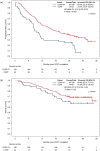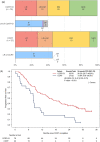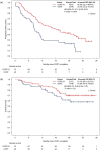Recurrence patterns and progression-free survival after chemoradiotherapy with or without consolidation durvalumab for stage III non-small cell lung cancer
- PMID: 36149029
- PMCID: PMC9855316
- DOI: 10.1093/jrr/rrac057
Recurrence patterns and progression-free survival after chemoradiotherapy with or without consolidation durvalumab for stage III non-small cell lung cancer
Abstract
Chemoradiotherapy followed by consolidation durvalumab (CCRT+D) improves survival in patients with stage III non-small-cell lung cancer (NSCLC). We compared recurrence patterns and survival in the CCRT+D and CCRT cohorts. We conducted a multicenter, retrospective study in Japan. Patients who received CCRT for stage III NSCLC were included in this study. Of 178 eligible patients, 136 were in the CCRT+D and 42 were in the CCRT cohorts. Locoregional recurrence (LR), LR plus distant metastases (DM), and DM were observed in 20.6%, 8.8%, 27.9% of the CCRT+D, and 26.2%, 16.7% and 33.3% of the CCRT cohorts, respectively. In-field recurrence was the most common LR pattern in both cohorts. Squamous cell carcinoma and PD-L1 expression < 1%, and female sex and EGFR mutations were significantly associated with an increased risk of LR and DM. In patients with any risk factors for LR, the incidence of LR was similar in the CCRT+D and CCRT (39.5% vs 45.5%). The 24 month progression-free survival (PFS) and overall survival (OS) were 40.3% and 69.4% in the CCRT+D and 24.7% and 61.0% in the CCRT cohorts, respectively. Poor performance status and no consolidation durvalumab were significantly associated with shorter PFS. There was a significant difference in PFS between the CCRT+D and CCRT in the propensity score-matched cohort (HR = 0.51, P = 0.005). In conclusion, consolidation durvalumab decreased both LR and DM, and significantly improved PFS. However, in-field recurrence was still a major problem, as well as DM.
Keywords: distant metastasis; immunotherapy; locoregional recurrence (LR); real-world data.
© The Author(s) 2022. Published by Oxford University Press on behalf of The Japanese Radiation Research Society and Japanese Society for Radiation Oncology.
Figures





Similar articles
-
Real-world experience of consolidation durvalumab after concurrent chemoradiotherapy in stage III non-small cell lung cancer.Thorac Cancer. 2022 Nov;13(22):3152-3161. doi: 10.1111/1759-7714.14667. Epub 2022 Sep 30. Thorac Cancer. 2022. PMID: 36177913 Free PMC article.
-
Contribution of Enhanced Locoregional Control to Improved Overall Survival with Consolidative Durvalumab after Concurrent Chemoradiotherapy in Locally Advanced Non-Small Cell Lung Cancer: Insights from Real-World Data.Cancer Res Treat. 2024 Jul;56(3):785-794. doi: 10.4143/crt.2023.1014. Epub 2024 Jan 16. Cancer Res Treat. 2024. PMID: 38228082 Free PMC article.
-
Real-world treatment patterns and outcomes among unresectable stage III non-small cell lung cancer.PLoS One. 2024 Nov 25;19(11):e0314156. doi: 10.1371/journal.pone.0314156. eCollection 2024. PLoS One. 2024. PMID: 39585843 Free PMC article.
-
Immune checkpoint-inhibitors and chemoradiation in stage III unresectable non-small cell lung cancer.Lung Cancer. 2019 Aug;134:259-267. doi: 10.1016/j.lungcan.2019.05.027. Epub 2019 May 29. Lung Cancer. 2019. PMID: 31319991 Review.
-
The effect of consolidation chemotherapy after concurrent chemoradiation on the prognosis of locally advanced cervical cancer: a systematic review and meta-analysis.J Obstet Gynaecol. 2022 Jul;42(5):830-837. doi: 10.1080/01443615.2021.2012437. Epub 2022 Feb 11. J Obstet Gynaecol. 2022. PMID: 35148230
Cited by
-
Clinical Outcome of Nivolumab Plus Ipilimumab in Patients with Locally Advanced Non-Small-Cell Lung Cancer with Relapse after Concurrent Chemoradiotherapy followed by Durvalumab.Cancers (Basel). 2024 Apr 3;16(7):1409. doi: 10.3390/cancers16071409. Cancers (Basel). 2024. PMID: 38611087 Free PMC article.
-
Durvalumab Prolongs Overall Survival, Whereas Radiation Dose Escalation > 66 Gy Might Improve Long-Term Local Control in Unresectable NSCLC Stage III: Updated Analysis of the Austrian Radio-Oncological Lung Cancer Study Association Registry (ALLSTAR).Cancers (Basel). 2025 Apr 25;17(9):1443. doi: 10.3390/cancers17091443. Cancers (Basel). 2025. PMID: 40361370 Free PMC article.
-
Prognostic significance of initial tumor shrinkage in patients with stage III non-small cell lung cancer treated with durvalumab following chemoradiotherapy.Int J Clin Oncol. 2024 Feb;29(2):115-123. doi: 10.1007/s10147-023-02436-5. Epub 2023 Nov 30. Int J Clin Oncol. 2024. PMID: 38032455
-
Development of brain metastases in patients managed with non-curative thoracic radiotherapy for stage II/III non-small cell lung cancer.Discov Oncol. 2024 Sep 27;15(1):495. doi: 10.1007/s12672-024-01358-6. Discov Oncol. 2024. PMID: 39331216 Free PMC article.
-
Conversion therapy with immunotherapy plus chemotherapy achieves a pathological complete response in stage IIIC NSCLC.Front Immunol. 2023 Nov 3;14:1268153. doi: 10.3389/fimmu.2023.1268153. eCollection 2023. Front Immunol. 2023. PMID: 38022567 Free PMC article.
References
-
- Aupérin A, Le Péchoux C, Rolland E et al. Meta-analysis of concomitant versus sequential radiochemotherapy in locally advanced non-small-cell lung cancer. J Clin Oncol 2010;28:2181–90. - PubMed
-
- National Comprehensive Cancer Network . Non-Small Cell Lung Cancer (Version 1.2022). https://www.nccn.org/professionals/physician_gls/pdf/nscl.pdf Accessed February 22 2022.
-
- Antonia SJ, Villegas A, Daniel D et al. Overall survival with Durvalumab after Chemoradiotherapy in stage III NSCLC. N Engl J Med 2018;379:2342–50. - PubMed
Publication types
MeSH terms
Substances
Grants and funding
LinkOut - more resources
Full Text Sources
Medical
Research Materials
Miscellaneous

